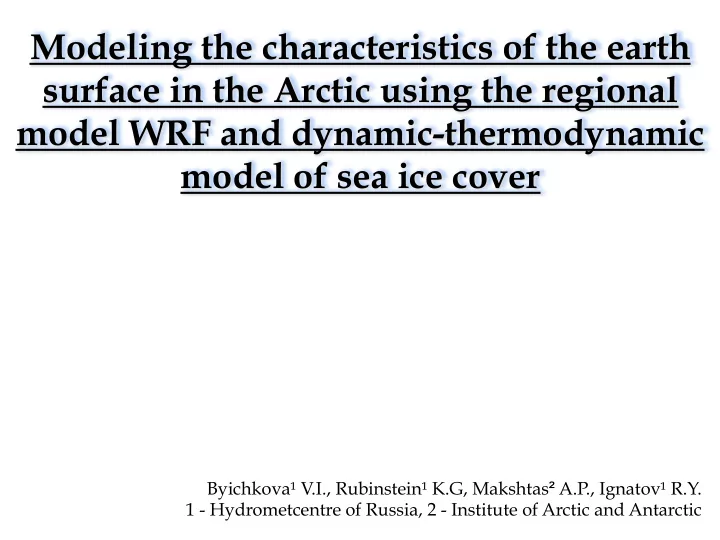

Modeling the characteristics of the earth surface in the Arctic using the regional model WRF and dynamic-thermodynamic model of sea ice cover Byichkova ¹ V.I., Rubinstein ¹ K.G, Makshtas ² A.P., Ignatov ¹ R.Y. 1 - Hydrometcentre of Russia, 2 - Institute of Arctic and Antarctic
Purposes of work: • To adapt the mesoscale meteorological model WRF to conditions of the observation polar region, based on a unique data archive of the annual cycle of observations in free atmosphere, the boundary layers of the atmosphere and ocean snow and ice cover, performed in 2007-2008 on the drifting stations “North Pole - 35 “ and “North Pole – 36” • Т o perform validation thermodynamic and dynamic-thermodynamic models of sea ice cover for the Arctic Basin. Radiosoundings Balloon soundings Wind direction Wind velocity Air temperature and humidity Incoming and outgoing short sensors and longwave radiation Meteo station MAWS110 Visibility Surface temperature Ozonometer М -124 Inlets for analyzers of CO 2 and O 3 Spectrometer Ramses
The variant with parameterization of radiation RRTMG, turbulence - Moninu-Obuhovu-Janichu scheme, boundary layer – Buzho-Lokareru scheme has appeared the best. U a N ( z z ) 2 χ Δ + χ − u 2 1 U = ∂ θ 1.8 * z z z Richardson − 1.6 g (ln 2 2 1 ) z + β number ∂ Ri u 1.4 = z L 2 2 1.2 u θ ∂ ⎛ ⎞ r 1 ⎜ ⎟ χ Δ θ z θ = 0.8 ∂ ⎝ ⎠ * 3 z z z Fr ( z z ) − − 0.6 (ln 8 C 2 1 C C 2 1 ) + + 0.4 o o N z L L 2 0.2 0 1 2 3 4 5 6 7 8 9 10 11 12 13 14 15 16 17 18 19 20 21 22 23 24 25 26 27 28 29 30 30 20 10 0 1 2 3 5 6 8 9 11 12 13 15 16 18 19 20 22 23 25 26 28 29 30 -10 -20 -30 Heat flux -40 -50 -60 HFX (N) HFX
We used the dynamic-thermodynamic model of sea ice cover (Institute of Arctic and Antarctic). The model calculates the spatial and temporal characteristics of snow and ice, the turbulent fluxes, sensible and latent heat, short-and long-wave radiation balance. The computational domain is 50x50 km, centered at the North Pole. We used the following output fields: the average cohesion of ice (with areal weights of level ice and ice ridges) and a sign of the cell (water or ice). 45000000 40000000 35000000 30000000 25000000 20000000 15000000 10000000 5000000 0 1 jan 1 feb 1 mar 1 apr 1 mai 1 jun 1jul 1 aug 1 sep 1 о kt 1 nov 1 dec Water to 30% of ice to 60% of ice to 90% of ice Ice Ice cohesion changing during 2007 year by 2 models AARI (continuous line) and NCAR (dashed line)
Difference of ice cohesion between AARI and NCAR 1.06.2007 and 31.12.2007
Thank you for attention. Waiting for the question near the poster.
Recommend
More recommend